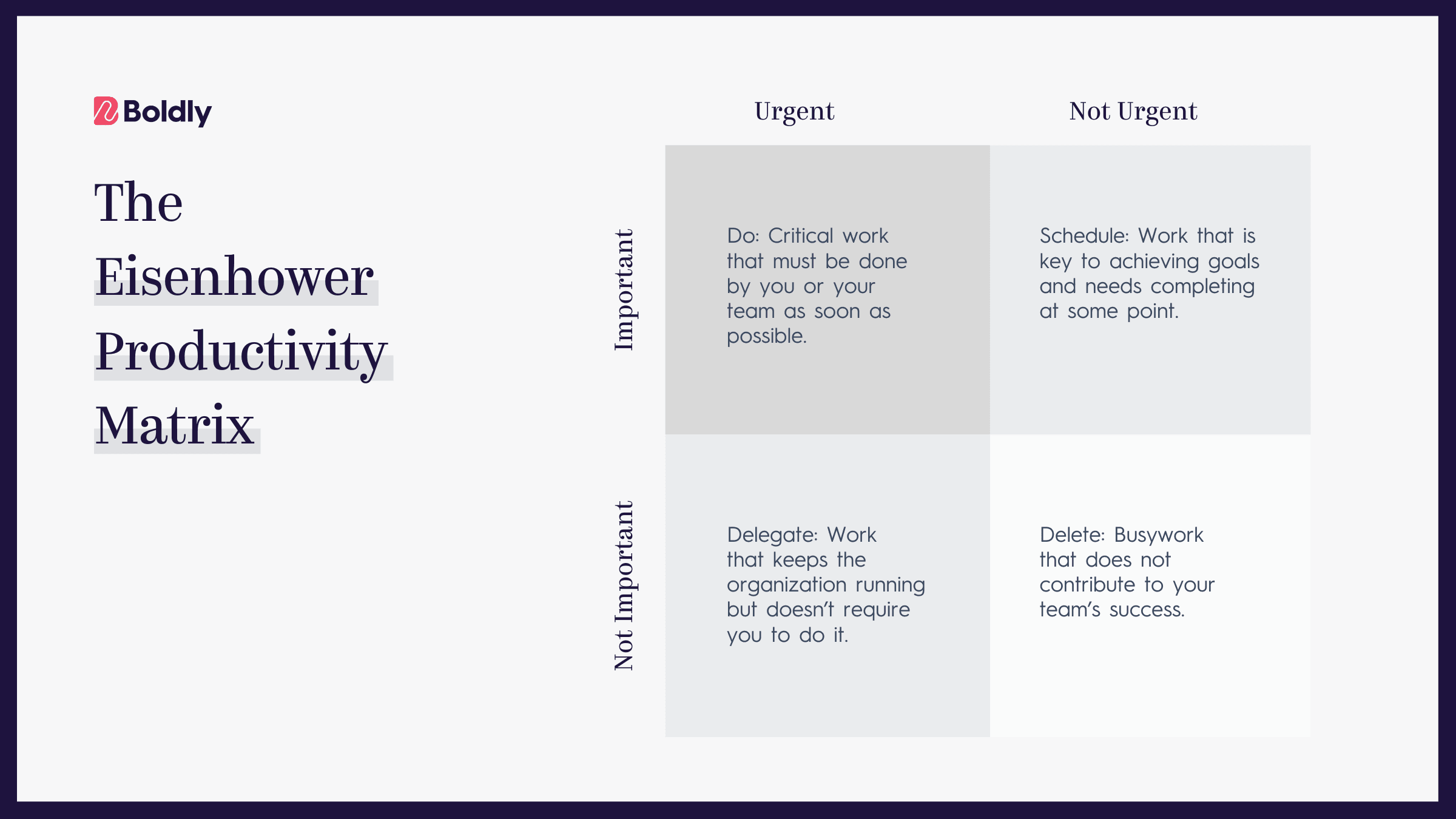A 10-year analysis of 17,000 CEOs found that decisiveness is the top trait of the best CEOs.
That’s right. It’s not charisma, confidence, or pedigree but the ability to make good decisions. We’ve seen this proven true in working with hundreds of top leaders—many at Fortune 500s.
Yet, there’s often a missing connection in extending that decisiveness to how a CEO works. What happens when leaders are also decisive about the nature of the work they’re taking on? Does that trickle down to their team?
After helping thousands of senior executives increase their productivity, we have found the three keys the most effective leaders use to stop busy work so they can increase their productivity. We’ll break down the question of how to become more effective at work into a simple 3-part productivity framework for:
- Doing your highest-impact work.
- Mastering task delegation.
- Become more productive with one simple decision.
Not only will busy senior execs see an increase in actual productivity, but they’ll also see it in their team.
How Senior Executives Can Reduce Busy Work
Improving time management and prioritizing work that matters means reducing busy work.
When you understand that anything an executive dedicates time and energy to becomes a strategic allocation of company resources, the problem of busy work is evident. That means that as a senior executive, you should:
- Do the work that only you can do. This is your purpose in your work.
- Delegate out other critical work. This is what your team is for.
- Delete work that doesn’t move the needle. If it doesn’t help accomplish a strategic goal, dump it.
You can do this and quickly answer how to be more effective at work without adding more hours, effort, or energy to the mix.
What Does “Productivity” Mean For Executives?
Too many executives don’t understand what productivity actually looks like or that it has an even more significant impact beyond an executive.
In High Output Management, Andy Grove, former CEO of Intel, reveals that a manager’s effectiveness is measured by the output of their team and adjacent teams under their influence.
Imagine getting the news that your team spent 62% of its time on administrative tasks. As a senior executive, how would you handle that? Would you tolerate 38% productivity?
Probably not.
Yet an Asana study of 10,264 employees found that it comprises the average manager’s day. That’s concerning for any senior executive, especially when you consider, as Grove noted, that the team reflects its leadership.
As the saying goes, the “speed of the leader is the speed of the team.” An indecisive leader produces a slower, less productive team. That circles back into busy work landing in the lap of managers and executives who should have a results-oriented focus instead of being lost in administrative tasks others can do.
Increased productivity means getting better results in less time and with less effort. Grove says productivity is not about personal efficiency but how well their team achieves growth goals.
So, how do you become more productive as an exec with all this in mind?
A Battle-Tested Productivity Matrix
Your time and attention are strategic deployments of your company’s resources, of which your team is the most valuable resource.
Leaders determine what gets measured because that’s what gets done. Being decisive about this signals the team about what’s important. Allowing unnecessary to-dos and cling-on projects is like planting weeds. They don’t produce much fruit, but they grow fast and steal resources from what matters.
Though there are many methods for time management, a popular approach is to use the Eisenhower Matrix to determine what are weeds and what is essential. President Eisenhower created a fundamental four-box matrix to help him navigate the unimaginable complexity of leadership on a global scale. This kind of prioritization works well for any busy senior executive.
Eisenhower broke work down into whether something was important or urgent. The first is a question of value, and the second is a question of time.
- Urgent + Important: You or your team must do critical work as soon as possible.
- Not Urgent + Important: Work that is key to achieving your team’s goals and needs to be completed at some point in the future.
- Not Important + Urgent: Work that needs to be completed to keep the organization running but can be delegated to your team.
- Not Important + Not Urgent: Busywork that doesn’t contribute to your success and wastes company resources.


It’s a deceptively simple matrix and only takes a few moments to run any project or task through the grid. Once finished, a busy exec can either do, delegate, or delete.
1. Do The Work Only You Can Do
There is work that only the leader can do, represented in the top row of the matrix. Think of things like:
- Business or group strategy
- Creating new products or services
- Key decision making
- Price or offer structuring
- Hiring and firing key team members
- Working with the CEO, board, or peer leaders
- Building relationships and developing a positive company culture
You’ll need to learn to delegate to accomplish this level of deep work. That means letting go of some control and trusting your team.
2. Delegate Tasks Using The “5Cs Of Delegation”
A 2015 Gallup study of 143 Inc. 500 CEOs found that companies run by senior executives who delegate well posted an average 3-year growth rate of 1,751%. That was 112 percentage points more than those with limited delegation skills.
Delegation, not overwork, is the actual executive superpower. And it starts by understanding your team and what they need to do work that yields results.
There are five parts to delegating tasks:
- Clarity: Define clear outcomes for your team’s efforts
- Creativity: Encourage autonomy in processes and working styles
- Culture: Build a healthy, productive, positive work environment
- Communication: Establish feedback loops and regular checkpoints
- Consideration: Give your team the resources to do the job right
![An infographic by Boldly titled 'A simple structure for effective delegation.' It presents a quote format: '[Who] will do [what] by [when].' Explanations for each part are provided:'[Who]': Name the person or team responsible.
'do [what]': A clear definition of the task.
'by [when]': Make the deadline as specific as possible.](https://boldly.com/wp-content/uploads/2022/06/Goal-Setting.png)
![An infographic by Boldly titled 'A simple structure for effective delegation.' It presents a quote format: '[Who] will do [what] by [when].' Explanations for each part are provided:'[Who]': Name the person or team responsible.
'do [what]': A clear definition of the task.
'by [when]': Make the deadline as specific as possible.](https://boldly.com/wp-content/uploads/2022/06/Goal-Setting.png)
An easy way to start delegating is by taking a task and assigning it in this template: {Who} will do {what} by {when}.
Things get done when everyone knows who owns an action, what success looks like, and has a deadline. This method works for large-scale projects and daily, weekly, or monthly tasks.
What If There Is No One To Delegate Tasks To?
What do you do if your team is at capacity or you don’t have anyone to delegate to?
- Consider adding fractional staff, such as a remote executive assistant.
- Leverage automation tools to alleviate routine tasks.
One of the most incredible productivity hacks for senior executives is hiring a fractional, remote executive assistant. It’s this kind of delegation that has a high ROI, and it’s where we’ve seen Boldly EAs shine brightest.
Take email, for example.
A fractional EA can easily filter, distill, and answer most of them in a few hours a week. Instead of constantly checking your inbox, interrupting deep work, or blowing your time blocking out of the water, you can trust your executive assistant to alert you only to strategic communications.
Automation plays a role, too.
There are tasks that technology, such as AI, can handle for you or your team. There are tools like Zapier that you can use to connect apps and automate thousands of processes. Or use Calendly can reduce the back-and-forth of scheduling meetings and remind you of essential follow-ups and action items.
There’s magic where people (delegation) and tech (automation) intersect.
3. Delete Work That Doesn’t Move The Needle
After sorting out your work and the delegated work, delete what’s left by determining if the task contributes meaningfully to goals.
Meaningful contribution simply means it either helps you:
- Achieve your goals sooner, or
- Significantly increases margins through cost-cutting or profit increase.
What kind of work is commonly deleted?
- Non-essential meetings or meetings that get off-track,
- Overly fancy presentations and slide decks,
- Useless reports or briefs that don’t expedite decisions,
- Answering questions team members can find answers to
Not sure if you should delete a task?
Pause it for a week. Measure if it was missed. You’ll know soon enough.
Unleash Your Productivity And Eliminate Busy Work For Good
The secret of how to be more productive at work is do, delegate, and delete. It’s simple, but it will change how any busy senior executive works for good.
We know this because we focus on helping busy executives become more productive, and we have seen this approach work repeatedly. With this framework, your leadership will result in a productive team that trickles up to you.
We specialize in productivity because great leaders with excellent teams can change business for the better. This framework will increase your leadership results and actual productivity.
If a lack of critical support staff, like an executive assistant, is holding you back, we can help.




